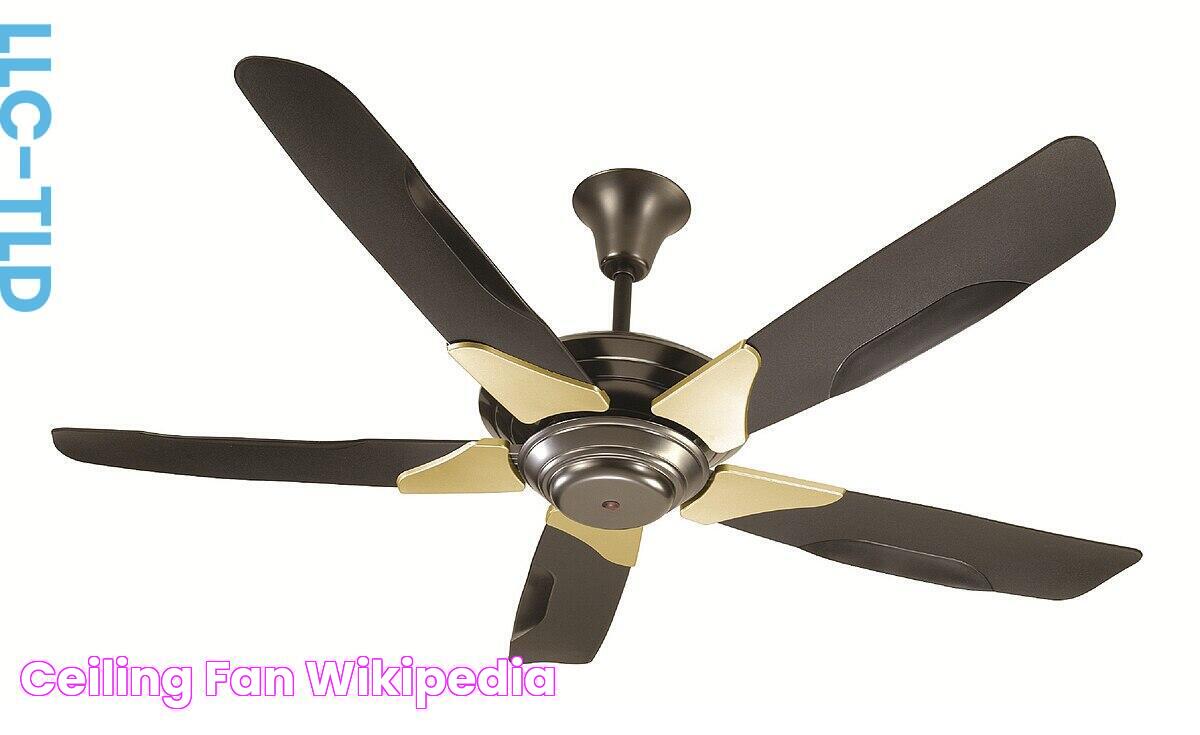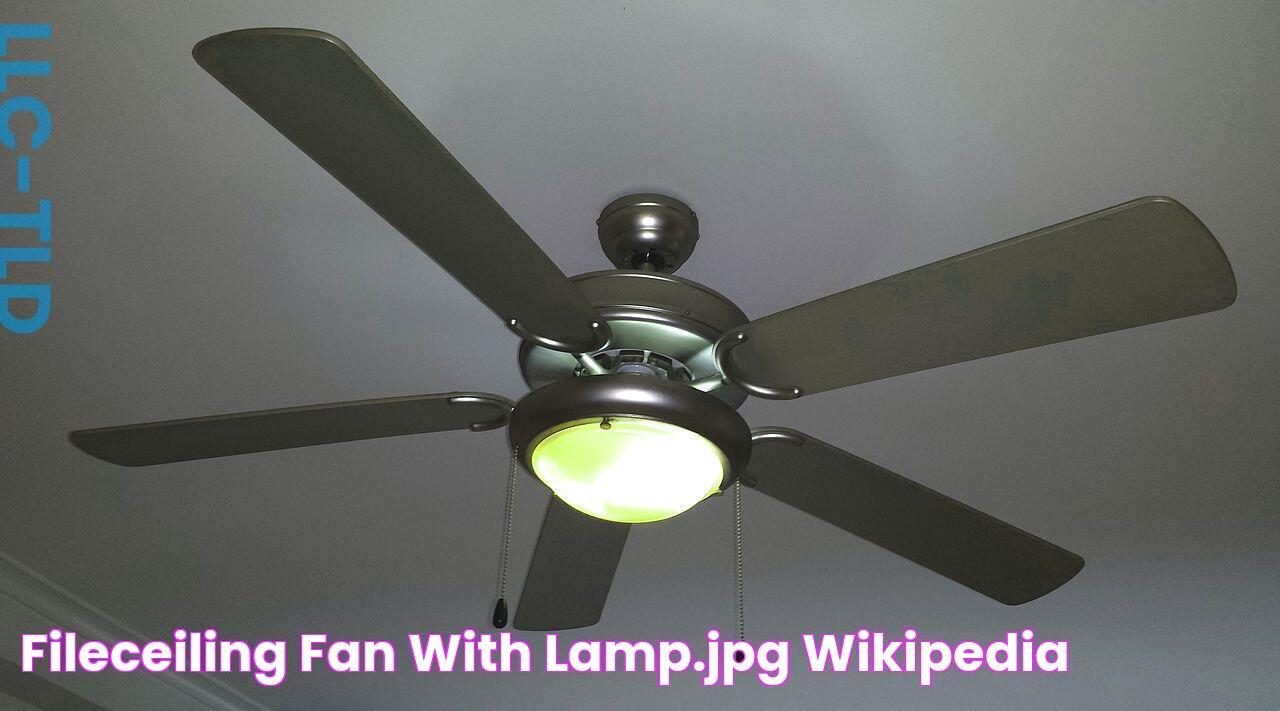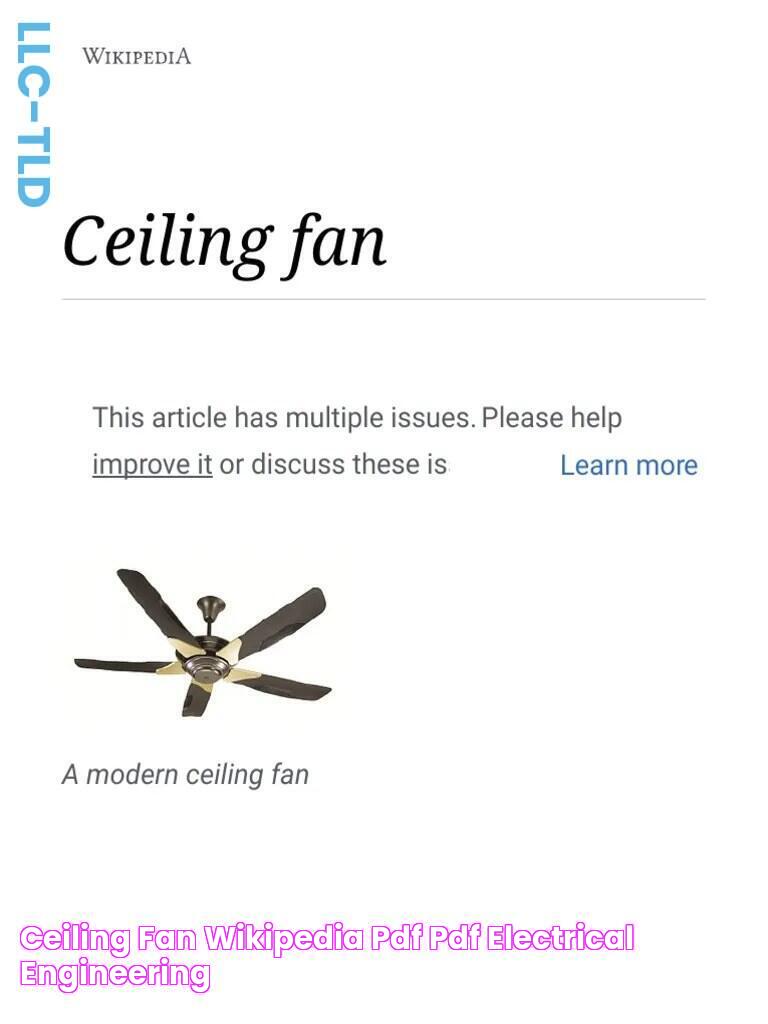The Ultimate Ceiling Fans Wiki: Everything You Need To Know
A ceiling fan wiki is an online encyclopedia that provides information about ceiling fans. It can include articles on different types of ceiling fans, their history, how to install and maintain them, and how to troubleshoot problems. Ceiling fan wikis can be a valuable resource for homeowners, renters, and anyone else who wants to learn more about ceiling fans.
Ceiling fans have been around for centuries, and they have evolved significantly over time. Early ceiling fans were simple devices that were powered by hand or by a small motor. Today, ceiling fans are available in a wide variety of styles and sizes, and they can be used to circulate air, provide light, and even add a decorative touch to a room. Ceiling fans can also be energy-efficient, helping to reduce cooling costs in the summer.
If you are considering purchasing a ceiling fan, there are a few things you should keep in mind. First, you will need to decide what type of fan you want. There are three main types of ceiling fans: traditional, contemporary, and modern. Traditional ceiling fans have a classic look that is perfect for homes with traditional dcor. Contemporary ceiling fans have a more modern look that is perfect for homes with contemporary dcor. Modern ceiling fans have a sleek, minimalist look that is perfect for homes with modern dcor.
Read also:Discover The Unseen World Of Elliot De Niro
Ceiling Fans Wiki
A ceiling fan wiki is an online encyclopedia that provides information about ceiling fans. It can include articles on different types of ceiling fans, their history, how to install and maintain them, and how to troubleshoot problems. Ceiling fan wikis can be a valuable resource for homeowners, renters, and anyone else who wants to learn more about ceiling fans.
- Types: Traditional, contemporary, modern
- History: From hand-powered to modern marvels
- Installation: DIY or professional
- Maintenance: Keeping your fan running smoothly
- Troubleshooting: Common problems and solutions
- Energy efficiency: Reducing cooling costs
- Decoration: Adding style to your home
Ceiling fan wikis can provide a wealth of information on all aspects of ceiling fans. Whether you are looking to learn more about the history of ceiling fans, how to install or maintain them, or how to troubleshoot problems, a ceiling fan wiki can be a valuable resource. Additionally, ceiling fan wikis can provide information on the latest trends in ceiling fan design and technology, helping you to make informed decisions about your next purchase.
1. Types
Ceiling fan wikis provide comprehensive information on the various types of ceiling fans available, including traditional, contemporary, and modern styles. This classification is essential for users to understand the diverse design aesthetics and functional features associated with ceiling fans.
- Traditional
Traditional ceiling fans evoke a classic and timeless appeal. They often feature intricate detailing, ornate finishes, and curved blades, complementing homes with traditional or vintage dcor. These fans add a touch of elegance and sophistication to any space. - Contemporary
Contemporary ceiling fans embody a sleek and streamlined aesthetic. They showcase clean lines, neutral tones, and geometric shapes. These fans are ideal for modern or contemporary homes, blending seamlessly with existing dcor and creating a sophisticated ambiance. - Modern
Modern ceiling fans exude a cutting-edge and minimalist design. They incorporate innovative materials, such as metal and acrylic, and feature bold shapes and unique finishes. These fans make a statement in contemporary or industrial-style homes, adding a touch of edginess and urban flair.
By providing detailed information on these types, ceiling fan wikis empower users to make informed decisions when selecting a ceiling fan that aligns with their personal style and home dcor. The comprehensive coverage of traditional, contemporary, and modern styles ensures that users can find the perfect fan to complement their living spaces.
2. History
Ceiling fans have a long and fascinating history, dating back to the early days of human civilization. The earliest ceiling fans were simple devices, consisting of a few blades attached to a motor. These fans were often hand-powered, and they were used to provide relief from the heat in hot climates. Over time, ceiling fans evolved, and they became more efficient and powerful. Today, ceiling fans are a common sight in homes and businesses all over the world.
Ceiling fans wikis play an important role in preserving the history of ceiling fans. These wikis document the evolution of ceiling fans, from their humble beginnings to the modern marvels that they are today. They also provide information on the different types of ceiling fans that are available, as well as tips on how to install and maintain them. Ceiling fans wikis are a valuable resource for anyone who is interested in learning more about these fascinating devices.
Read also:Indulge In The Distinct Flavor Discover The Unique Taste Of Target Keyword
The history of ceiling fans is important because it helps us to understand how these devices have evolved over time. This knowledge can help us to make informed decisions about the type of ceiling fan that we purchase. It can also help us to appreciate the craftsmanship and ingenuity of the people who have designed and built ceiling fans over the centuries.
3. Installation
Ceiling fan wikis provide comprehensive guidance on whether to install a ceiling fan yourself (DIY) or hire a professional. This crucial decision involves understanding the complexities of electrical work, safety considerations, and potential cost savings.
- DIY Installation
DIY installation can be suitable for individuals with basic electrical knowledge and experience. Ceiling fan wikis offer detailed instructions, diagrams, and troubleshooting tips to assist with the process. This option provides cost savings but requires careful planning and adherence to safety guidelines.
- Professional Installation
Hiring a licensed electrician ensures expert handling of electrical connections, proper mounting, and adherence to building codes. Professionals have the necessary tools, experience, and insurance to minimize risks and ensure a safe and functional installation. While it may involve higher upfront costs, it provides peace of mind and long-term reliability.
Ceiling fan wikis empower users to weigh the pros and cons of DIY versus professional installation, considering their skill level, time constraints, and budget. By providing comprehensive information and expert advice, these wikis enable informed decision-making and ensure a successful ceiling fan installation experience.
4. Maintenance
Maintenance is crucial for ensuring the longevity and optimal performance of ceiling fans. Ceiling fans wikis provide comprehensive guidance on maintenance procedures, empowering users to keep their fans running smoothly and efficiently.
- Regular Cleaning
Regular cleaning removes dust and debris from fan blades, motor, and housing, preventing buildup that can affect performance and air circulation. Ceiling fans wikis provide step-by-step instructions for safe and effective cleaning methods.
- Lubrication
Proper lubrication reduces friction and wear on moving parts, extending the lifespan of the fan. Ceiling fans wikis offer guidance on identifying lubrication points and selecting the appropriate lubricant for different fan models.
- Blade Balancing
Balanced fan blades ensure smooth operation and prevent wobbling. Ceiling fans wikis provide methods for checking blade balance and instructions for rebalancing, ensuring optimal air distribution and reducing noise.
- Electrical Safety Checks
Electrical safety is paramount. Ceiling fans wikis emphasize the importance of regular electrical checks, including inspecting wires, connections, and switches for any damage or loose connections. These checks help prevent electrical hazards and ensure safe operation.
By providing detailed maintenance procedures, ceiling fans wikis empower users to maintain their fans, prolonging their lifespan, enhancing their performance, and ensuring the continued comfort and efficiency of their living spaces.
5. Troubleshooting
Troubleshooting is an essential component of ceiling fans wiki, providing users with practical guidance to address common problems and maintain optimal fan performance. Ceiling fans wiki offers comprehensive troubleshooting sections that empower users to diagnose and resolve issues, ensuring continued comfort and efficient air circulation in their living spaces.
By providing clear instructions and step-by-step solutions, ceiling fans wiki empowers users to address issues such as:
- Fan wobbling or making noise
- Fan not spinning or responding to controls
- Electrical problems, including humming or sparking
- Remote control malfunctioning or not pairing
- Unusual odors or smoke coming from the fan
The troubleshooting section in ceiling fans wiki serves as a valuable resource for users to maintain their fans, extending their lifespan and enhancing their performance. It promotes self-sufficiency, enabling users to resolve common issues without the need for professional assistance, resulting in cost savings and peace of mind.
Overall, the connection between troubleshooting and ceiling fans wiki is crucial, providing users with the knowledge and resources to maintain their fans, ensuring optimal performance and continued comfort in their living spaces.
6. Energy efficiency
In the pursuit of energy efficiency and cost reduction, ceiling fans wiki plays a significant role by providing valuable information on how ceiling fans can contribute to lowering cooling costs. Ceiling fans circulate air, creating a wind chill effect that makes people feel cooler, allowing thermostats to be set at a higher temperature without sacrificing comfort.
The U.S. Department of Energy estimates that ceiling fans can reduce cooling costs by up to 40%. This is because ceiling fans use significantly less energy than air conditioners, while still providing a cooling effect. Additionally, ceiling fans can help to reduce the load on air conditioners, which can prolong their lifespan and reduce maintenance costs.
Ceiling fans wiki provides detailed information on the energy-efficient features of different ceiling fan models, including:
- Energy Star ratings
- DC motors
- Variable speed settings
- Smart controls
By providing comprehensive information on energy-efficient ceiling fans, ceiling fans wiki empowers users to make informed decisions about their cooling options, leading to reduced energy consumption, lower cooling costs, and a more sustainable lifestyle.
7. Decoration
Ceiling fans wiki explores the connection between ceiling fans and home dcor, highlighting the significant role that ceiling fans play in enhancing the style and ambiance of living spaces.
Ceiling fans are not just functional appliances for air circulation; they can also be decorative elements that complement the overall design scheme of a room.
Ceiling fans wiki provides valuable information on various decorative aspects of ceiling fans, including:
- Style and design: Modern, traditional, contemporary, industrial, and other styles to match different dcor themes.
- Color and finish: Options to match existing color palettes and finishes, creating a cohesive look.
- Blade design: Different shapes, sizes, and materials to complement the style and size of the room.
- Lighting: Integrated lighting options to provide both illumination and ambiance.
By providing comprehensive information on the decorative aspects of ceiling fans, ceiling fans wiki empowers users to make informed decisions about selecting fans that not only provide cooling but also enhance the visual appeal of their homes.
Ceiling Fans Wiki
Ceiling Fans Wiki provides comprehensive information about ceiling fans, covering various aspects such as types, history, installation, maintenance, troubleshooting, energy efficiency, and decoration. To further assist users, we have compiled a list of frequently asked questions (FAQs) to address common concerns and misconceptions.
Question 1: What are the different types of ceiling fans?Ceiling fans come in three main types: traditional, contemporary, and modern. Traditional fans feature intricate detailing and curved blades, contemporary fans have clean lines and neutral tones, while modern fans showcase bold shapes and innovative materials.
Question 2: Are ceiling fans energy-efficient?Yes, ceiling fans can contribute to energy efficiency. By circulating air and creating a wind chill effect, they allow you to raise the thermostat setting without compromising comfort. This can lead to reduced cooling costs, especially during summer.
Question 3: Can I install a ceiling fan myself?Whether to install a ceiling fan yourself or hire a professional depends on your electrical knowledge and experience. Ceiling Fans Wiki provides detailed instructions and safety guidelines for DIY installation, but if you are not confident, it is recommended to consult a licensed electrician.
Question 4: How often should I clean my ceiling fan?Regular cleaning is essential to maintain optimal performance and prevent dust buildup. Ceiling Fans Wiki provides step-by-step instructions for safely cleaning your fan's blades, motor, and housing.
Question 5: What should I do if my ceiling fan is wobbling?Wobbling can be caused by unbalanced fan blades. Ceiling Fans Wiki offers methods for checking blade balance and provides instructions for rebalancing to ensure smooth operation and minimize noise.
Question 6: Can ceiling fans be used for both cooling and heating?While ceiling fans primarily provide cooling by circulating air, some models come with a reverse function. This allows them to rotate clockwise during winter months, pushing warm air down from the ceiling and creating a more comfortable temperature distribution.
By providing answers to these common questions, Ceiling Fans Wiki aims to empower users with the knowledge and resources they need to make informed decisions about ceiling fans, ensuring optimal performance, energy efficiency, and a comfortable living environment.
For more in-depth information on these and other related topics, please explore the comprehensive articles and resources available on Ceiling Fans Wiki.
Ceiling Fan Tips
Ceiling fans are a great way to keep your home cool and comfortable during the summer months. They can also help you save money on your energy bills. Here are a few tips for getting the most out of your ceiling fan:
Tip 1: Choose the right size fan for your room.
The size of your ceiling fan will determine how effectively it can cool your room. A fan that is too small will not be able to circulate enough air, while a fan that is too large may be too noisy or drafty. To choose the right size fan, measure the width and length of your room and then multiply those numbers together. The result will be the square footage of your room. You can then use the following chart to determine the appropriate fan size for your room:
| Room Size (Sq. Ft.) | Fan Size (Inches) |
|---|---|
| Up to 75 | 29-36 |
| 75-150 | 36-42 |
| 150-225 | 44-52 |
| 225-300 | 52-60 |
| 300+ | 60+ |
Tip 2: Install your fan at the correct height.
The height at which you install your ceiling fan will affect its effectiveness. The fan should be installed high enough so that the blades are at least 7 feet above the floor. This will help to ensure that the air is circulated throughout the room.
Tip 3: Use your fan in conjunction with your air conditioner.
Ceiling fans can help you save money on your energy bills by reducing the amount of time that you need to run your air conditioner. By using your fan in conjunction with your air conditioner, you can set your thermostat a few degrees higher without sacrificing comfort.
Tip 4: Clean your fan regularly.
Dirt and dust can build up on your ceiling fan over time, which can reduce its efficiency. To clean your fan, simply wipe down the blades with a damp cloth. You should also vacuum the motor housing regularly.
Tip 5: Replace your fan's blades if they become damaged.
If your fan's blades become damaged, they can become unbalanced and cause the fan to wobble. This can be noisy and inefficient. If you notice that your fan is wobbling, you should check the blades for damage and replace them if necessary.
By following these tips, you can get the most out of your ceiling fan and keep your home cool and comfortable during the summer months.
Summary of Key Takeaways:
- Choose the right fan size for your room
- Install your fan at the correct height
- Use your fan in reverse during winter months
- Clean your fan regularly
- Replace your fan's blades if they become damaged
Conclusion:
Ceiling fans can be a great way to keep your home cool and comfortable during the summer months. By following the tips in this article, you can get the most out of your ceiling fan and extend its lifespan.
Conclusion
Ceiling Fans Wiki serves as a comprehensive and invaluable resource for anyone seeking in-depth knowledge about ceiling fans. It provides a wealth of information on various aspects, including types, history, installation, maintenance, troubleshooting, energy efficiency, and decoration.
The wiki empowers readers to make informed decisions when selecting, installing, and maintaining ceiling fans. It promotes energy efficiency, cost savings, and a comfortable living environment. By providing detailed explanations, expert advice, and troubleshooting tips, Ceiling Fans Wiki empowers individuals to enhance their homes and improve their quality of life.
Jennifer Lawrence's Journey From Abercrombie & Fitch To Hollywood Stardom
Memphis Bleek Record Labels: From Rawkus To Get Low Records
Discover The Ultimate Guide To Charlotte Tilbury's Finest For Mature Skin


